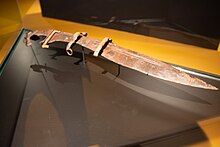A | B | C | D | E | F | G | H | CH | I | J | K | L | M | N | O | P | Q | R | S | T | U | V | W | X | Y | Z | 0 | 1 | 2 | 3 | 4 | 5 | 6 | 7 | 8 | 9

The falcata is a type of sword typical of pre-Roman Iberia. The falcata was used to great effect for warfare in the ancient Iberian peninsula, and is firmly associated with the southern Iberian tribes, among other ancient peoples of Hispania. It was highly prized by the ancient general Hannibal, who equipped Carthaginian troops with it during the Second Punic War.
Name
It is unknown which name ancient Iberians gave to the weapon. Falcata is neither a native name nor one used in classical sources, but a 19th century term coined by historian Fernando Fulgosio to describe the shape of its blade. The term derivates from Latin falcatus, meaning literally "falcon-shaped".[1][2] Classical vocabulary did have a sword named ensis falcatus, but it was apparently meant to be either a falx or a harpe. In any case, the name caught on very quickly and is now firmly entrenched in the scholarly literature.
Shape
The falcata has a single-edged blade that pitches forward towards the point, the edge being concave near the hilt, but convex near the point. This shape distributes the weight in such a way that the falcata is capable of delivering a blow with the momentum of an axe, while maintaining the longer cutting edge of a sword, as well as the facility to thrust. The grip is typically hook-shaped, the end often stylized in the shape of a horse or a bird. There is often a thin chain connecting the hooked butt of the handle with the hilt. Though almost identical to the Greek kopis, the falcata is distinguished by the sharpened false edge in the second half of its length.[3]
Origin

Some have posited that the falcata was derived from the sickle-shaped knives of the Iron Age; which coincides with their ritual use.[clarification needed] Some speculate it was introduced to the Iberian Peninsula by the Celts, along with iron working[who?]. There are several historians[who?] who believe that the falcata's origin is coincident to the Greek kopis without deriving from it. However, the extent of profound Hellenistic influence both west and east, Greek trade ports like Emporion (modern Empuries) from the 8th century BCE along the east coast of Iberia, the unequivocal archeological record of the kopis predating the falcata by centuries, as well as the utterly anomalous inward "recurve" configuration across the entire world history of blades heavily argues for the Greek origin and influence.
Quality and manufacture
Roman armies in the Second Punic War and later, during the Conquest of Hispania, were surprised by the quality of the weapons used by Iberian mercenaries and warriors. The overall quality of the falcata came not only from the shape, but also from the quality of the iron. It is said that steel plates were buried in the ground for two to three years, corroding the weaker steel from them, but this is technically nonsensical as the higher carbon content of the 'better' steel makes it more vulnerable to chemical corrosion. The technique of joining layers of steel in a fire-welding process in a forge was a standard procedure.[4]
Ornamental and liturgical uses

In the early times of the tribes in Iberia, its use was more ornamental and liturgical than military. Highly decorated falcata have been found in tombs, for example the Falcata de Almedinilla. The scarcity of the falcata during early times was due to the expense and scarcity of iron in the region.
In ancient texts
Since "falcata" is not a term used in Classical Latin, it is difficult to tell when, or even if, it is being referred to in ancient literature. There is, however, one passage that is generally agreed to refer to this type of sword, in Seneca's De Beneficiis 5.24:
A veteran who had been a bit too rough with his neighbors was pleading his case before Julius Caesar. "Do you remember," he said, "Imperator, how you twisted your ankle near Sucro?" When Caesar said he did remember: "Then you certainly remember that when you were lying to rest under a tree that was casting just a tiny shadow, in a very tough terrain with just that one lonely tree sticking out, one of your men laid out his cloak for you?"
Caesar said "Why shouldn't I remember, even if I was exhausted? Because I was unable to walk I couldn't go to the nearby spring, and I would have been willing to crawl there on hands and knees, if it were not for a good soldier, a brave industrious chap, hadn't brought me water in his helmet?" to which the man replied,
"Then, Imperator, you could recognize that man, or that helmet?" Caesar answered that he couldn't recognize the helmet, but certainly the man, and added, a bit irritated I think, "And you certainly are not him!" "It's not surprising," said the man, "that you do not recognize me, Caesar; for when that happened I was whole. Afterwards, at Munda my eye was gouged out, and my skull smashed in. Nor would you recognize that helmet if you saw it: it was split by a Hispanian sword (machaera Hispana)."
Polybius also calls Iberian swords machaera, possibly referring to the falcata given its similarities to the Greek makhaira.[2] However, he also employs this name for the straight swords used by the Gauls and even the Romans themselves.[5] The additional fact that other tribes from Hispania also used straight swords, which were later to inspire the Roman gladius, obscures the differentiation of their respective names.[6]
See also
Notes
- ^ In: Fulgosio, Fernando (1872): "Armas y utensilios del hombre primitivo en el Museo Arqueológico Nacional", in José Dorregaray (ed.),Museo Español de Antigüedades, Madrid, Vol. I, pp. 75-89.
- ^ a b Luis Silva, Viriathus and the Lusitanian Resistance to Rome 155-139 BC, 2013
- ^ "Sword (Falcata)". Metropolitan Museum of Art. Retrieved 25 November 2021.
- ^ Diodorus Siculus 5.33.4
- ^ F. Quesada Sanz, ¿Qué hay en un nombre? La cuestión del gladius hispaniensis Archived 2017-07-21 at the Wayback Machine, 1997.
- ^ F. Quesada Sanz, Gladius hispaniensis: an archaeological view from Iberia Archived 2018-08-10 at the Wayback Machine, 1997
Bibliography
- Aranegui, C. y De Hoz, J. (1992): “Una falcata decorada con inscripción ibérica. Juegos gladiatorios y venationes”, en Homenaje a Enrique Pla Ballester, Trabajos Varios del SIP 89, 319-344
- Cuadrado Díaz, E. (1989): La panoplia ibérica de “El Cigarralejo” (Mula, Murcia). Documentos. Serie Arqueología. Murcia
- Nieto, G. y Escalera, A. (1970): “Estudio y tratamiento de una falcata de Almedinilla”, Informes y trabajos del Instituto de Restauración y Conservación, 10
- F. Quesada Sanz: "Máchaira, kopís, falcata" in Homenaje a Francisco Torrent, Madrid, 1994, pp. 75-94.
- Quesada Sanz, F. (1991): “En torno al origen y procedencia de la falcata ibérica”. In J. Remesal, O.Musso (eds.), La presencia de material etrusco en la Península Ibérica, Barcelona Archived 2011-09-27 at the Wayback Machine
- Quesada Sanz, F. (1990b): “Falcatas ibéricas con damasquinados en plata”. Homenaje a D. Emeterio Cuadrado, Verdolay, 2, 45-59
- Quesada Sanz, F. (1992a): Arma y símbolo: la falcata ibérica. Instituto de Cultura Juan Gil-Albert, Alicante
- Quesada Sanz, F. (1992b): “Notas sobre el armamento ibérico de Almedinilla”, Anales de Arqueología Cordobesa, 3, 113-136
- Quesada Sanz, F. (1997a): “Algo más que un tipo de espada: la falcata ibérica”. Catálogo de la Exposición: La guerra en la Antigüedad. Madrid, pp. 196–205
- Quesada Sanz, F. (1997b): El armamento ibérico. Estudio tipológico, geográfico, funcional, social y simbólico de las armas en la Cultura Ibérica (siglos VI-I a.C.). 2 vols. Monographies Instrumentum, 3. Ed. Monique Mergoil, Montagnac, 1997
- Quesada Sanz, F. (1998): “Armas para los muertos”. Los íberos, príncipes de Occidente Catálogo de la Exposición. Barcelona, pp. 125–31
External links
>Text je dostupný pod licencí Creative Commons Uveďte autora – Zachovejte licenci, případně za dalších podmínek. Podrobnosti naleznete na stránce Podmínky užití.
File:Falcata ibérica (29158730100).jpg
Sword
Ancient Rome
Iberian Peninsula#History
Warfare in the ancient Iberian peninsula
Iberians
Hispania
Hannibal
Carthage
Second Punic War
Historian
Falcon
Falx
Harpe
Hilt
Kopis
File:Falcata de la Necrópolis de los Collados - M.A.N. 01.jpg
Almedinilla
Iron Age
Wikipedia:Please clarify
Celt
Wikipedia:Manual of Style/Words to watch#Unsupported attributions
Wikipedia:Manual of Style/Words to watch#Unsupported attributions
Ancient Greece
Kopis
Empuries
Roman army
Second Punic War
Conquest of Hispania
Pre-Roman peoples of the Iberian Peninsula
Mercenary
Steel#Ancient
File:Falcata íbera (M.A.N. Madrid) 03b.jpg
Almedinilla
Córdoba (Spanish province)
National Archaeological Museum of Spain
Madrid
Iberian Peninsula
ornamental
Liturgy
Classical Latin
Seneca the Younger
Julius Caesar
Imperator
Jucar
Battle of Munda
Polybius
Makhaira
Gaul
Gladius
Kopis
Makhaira
Khopesh
Kukri
Machete
Yatagan
Oakeshott typology
Metropolitan Museum of Art
Wayback Machine
Wayback Machine
Wayback Machine
Category:Falcatas
Autonomous University of Madrid
Template:Swords by region
Template talk:Swords by region
Special:EditPage/Template:Swords by region
Types of swords
Classification of swords
List of historical swords
Swordsmanship
Classification of swords#Edgeless and Thrusting swords
Classification of swords#Single-edge and Curved swords
Classification of swords#Double-edge and straight swords
Bronze Age sword
Khopesh
Ancient history
Iron Age sword
Harpe
Gladius
Xiphos
Kopis
Makhaira
Spatha
Sica
Rhomphaia
Falx
Post-classical history
Migration Period sword
Viking sword
Knightly sword
Longsword
Claymore
Falchion
Early modern period
Zweihänder
Spada da lato
Katzbalger
Cinquedea
Estoc
Espada ropera
Swiss degen
Colhona
Modern history#Late modern period
Rapier
Sabre
Cutlass
Basket-hilted sword
Small sword
Hunting sword
Pistol sword
Shashka
Spadroon
Sword bayonet
Chinese sword
Jian
Dao (Chinese sword)
Hook sword
Zhanmadao
Liuyedao
Wodao
Changdao
Yanmaodao
Dao (Chinese sword)
Miaodao
Korean sword
Liaoning bronze dagger culture
Hwandudaedo
Bonguk geom
Japanese sword
Chokutō
Tsurugi (sword)
Tachi
Ōdachi
Kodachi
Nagamaki
Tantō
Wakizashi
Katana
Guntō
Iaitō
Ninjatō
Shikomizue
Indian sword
Khanda (sword)
Urumi
Aruval
Firangi (sword)
Kastane
Talwar
Pulwar
Kayamkulam vaal
Pata (sword)
Bronze Age sword
Khopesh
Ancient history
Iron Age sword
Acinaces
Xiphos
Kopis
Post-classical history
Arab sword
Scimitar
Shamshir
Kilij
Turko-Mongol sabers
Yatagan
Mameluke sword
Early modern period
Qama
Kindjal
Template:Indonesian Weapons
Mandau (knife)
Niabor
Parang (knife)
Balato (sword)
Gari (sword)
Surik (sword)
Keris bahari
Klewang
Kalis
Langgai Tinggang
Parang Nabur
Sikin Panjang
Template:Filipino weapons
Balasiong
Bangkung
Banyal
Barong (sword)
Batangas sword
Bicuco
Bolo knife
Dahong palay
Gayang
Golok
Kampilan
Kalis
Karambit
Lahot
Laring
Panabas
Parang (knife)
Pirah
Pinuti
Sundang
Susuwat
Talibon (sword)
Utak
Balisword
Dha (sword)
Krabi–krabong
Preah Khan Reach
Phra Saeng Khan Chai Si
Macuahuitl
Macana
Khopesh
Acinaces
Template:Africa Weapons
Ida (sword)
Kaskara
Nimcha
Flyssa
Shotel
Billao
Takoba
Falcata
Falcata
Main Page
Wikipedia:Contents
Portal:Current events
Special:Random
Wikipedia:About
Wikipedia:Contact us
Special:FundraiserRedirector?utm source=donate&utm medium=sidebar&utm campaign=C13 en.wikipedia.org&uselang=en
Help:Contents
Help:Introduction
Wikipedia:Community portal
Special:RecentChanges
Wikipedia:File upload wizard
Main Page
Special:Search
Help:Introduction
Special:MyContributions
Special:MyTalk
Falcata
Falcata
Falcata
Falkata
Falcata
팔카타
Falcata (spada)
פלקטה
Фальката
Falcata
Falcata
ファルカタ
Falcata
Falcata
Falcata
Фальката
Falcata
Фальката
Special:EntityPage/Q1059687#sitelinks-wikipedia
Falcata
Talk:Falcata
Falcata
Falcata
Special:WhatLinksHere/Falcata
Special:RecentChangesLinked/Falcata
Wikipedia:File Upload Wizard
Special:SpecialPages
Special:EntityPage/Q1059687
Category:Falcatas
Falcata
Falcata
Main Page
Wikipedia:Contents
Portal:Current events
Special:Random
Wikipedia:About
Wikipedia:Contact us
Special:FundraiserRedirector?utm source=donate&utm medium=sidebar&utm campaign=C13 en.wikipedia.org&uselang=en
Help:Contents
Help:Introduction
Wikipedia:Community portal
Special:RecentChanges
Wikipedia:File upload wizard
Main Page
Special:Search
Help:Introduction
Special:MyContributions
Special:MyTalk
Falcata
Falcata
Falcata
Falkata
Falcata
팔카타
Falcata (spada)
פלקטה
Фальката
Falcata
Falcata
ファルカタ
Falcata
Falcata
Falcata
Фальката
Falcata
Фальката
Special:EntityPage/Q1059687#sitelinks-wikipedia
Falcata
Talk:Falcata
Falcata
Falcata
Special:WhatLinksHere/Falcata
Special:RecentChangesLinked/Falcata
Wikipedia:File Upload Wizard
Special:SpecialPages
Updating...x
Text je dostupný za podmienok Creative
Commons Attribution/Share-Alike License 3.0 Unported; prípadne za ďalších
podmienok.
Podrobnejšie informácie nájdete na stránke Podmienky
použitia.

